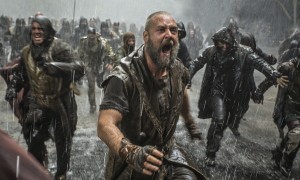Numerous Christian reviewers have pointed out that Darren Aronofsky’s movie Noah “takes liberties” with the biblical story of Noah. Indeed, the Bible doesn’t record any giant lava monsters, stowaways on the ark, or sacred serpent-skin relics. But the problem with Noah goes deeper than simply an imaginative portrayal of the details. Aronofsky fundamentally shifts the meaning and theology of the Noah story. As reviewer Brian Mattson points out, Aronofsky packed the movie with themes from the ancient heresy of Gnosticism, specifically a form of Jewish Gnosticism called Kabbalah (which the singer Madonna popularized in recent years). Essentially, Gnosticism teaches that all physical matter is evil, created as an accident by an inferior deity, and that the goal of life is to attain  “secret knowledge” that will free us from entrapment in the physical world. (The term “Gnosticism” derives from the Greek word for “knowledge.”) Gnosticism was a major threat to early Christianity and provoked extensive refutation from church fathers like Irenaeus of Lyons. It regained some prominence during the past decade thanks in part to mention in Dan Brown’s novel The Da Vinci Code.
“secret knowledge” that will free us from entrapment in the physical world. (The term “Gnosticism” derives from the Greek word for “knowledge.”) Gnosticism was a major threat to early Christianity and provoked extensive refutation from church fathers like Irenaeus of Lyons. It regained some prominence during the past decade thanks in part to mention in Dan Brown’s novel The Da Vinci Code.
Consider some of Noah’s Gnostic references. It depicts Adam and Eve as luminescent and fleshless until they eat the forbidden fruit and are relegated to the evil material world. Lesser divine beings (the Lava Monsters) redeem themselves, shed their material nature, and return to the heavens. As in Gnosticism, the god in Noah seems at times to be a violent lower deity. The serpent, often referred to as “Sophia,” “Mother,” or “Wisdom,” represents to Gnostics the true divine in contrast to the vindictive Creator of matter. This dovetails with Noah’s depiction of the Creator and Aronofsky’s eerie portrayal of a serpent skin from the Garden of Eden as the key to receiving blessing. Before Noah turns from his homicidal ways and professes love for his newborn granddaughters, he kills Tubal-Cain and recovers the serpent skin—possibly the inspiration for his enlightened perspective. The rainbow in Noah, which is circular like an important sign in Kabbalah, appears not as a sign of any covenant God makes with Noah but after Noah wraps the serpent skin around his arm and blesses his family. Probably not coincidentally, Aronofsky’s first feature film, Pi, also had Kabbalah as part of its subject matter.
Now consider the Noah story from Genesis. In that account, God is supreme and all-powerful, both a just judge and a merciful Savior, punishing mankind for its wickedness but preserving the human race by showing grace to a faithful remnant. The biblical God is a far cry from the cold deity of Noah who wants to wipe out all humans. Upon Noah’s exit from the ark, God professes His unflinching love for human life, forbidding murder and prescribing the death penalty for any who would destroy the crown jewel of His creation, “for God made man in his own image” (Genesis 9:6).
What’s more, in the Bible’s Noah story, there is nothing inherently evil about matter and no hint that we need to be freed from the material universe. In fact, when Noah exits the ark, God reissues the charge He gave Adam at creation: steward the earth, be fruitful, and multiply (Genesis 8:16-17). The New Testament holds up Noah as a model of faith who obeyed God even when it didn’t seem to make sense (Hebrews 11:7) and preached about God’s righteousness to his unbelieving neighbors (2 Peter 2:5). Again, a contrast to Aronofsky’s portrayal.
All this isn’t to say that you shouldn’t see the movie. That’s a decision for each person to make according to his or her conscience. But whether you see it or not, don’t let a Gnostic-influenced Hollywood director cloud your understanding of the facts or theology of Scripture. For an accurate picture of Noah, turn to Genesis 5-10 and Bible-based resources like BibleMesh’s The Biblical Story. There you’ll discover the true Noah, who “became an heir of the righteousness that comes by faith” (Hebrews 11:7).
//